The Samsung Galaxy S6 and S6 edge Review
by Joshua Ho on April 17, 2015 9:00 AM EST- Posted in
- Smartphones
- Samsung
- Mobile
- Galaxy S6
- Galaxy S6 Edge
Battery Life
At this point, it really goes without saying that battery life can make or break the experience of a smartphone. The anxiety that is associated with running out of battery is probably one of the worse experiences to have when using a smartphone, which is why good battery life is important. In theory, a phone should never run out of battery in a single day no matter the use case, but battery life is a complex issue to address. It’s common to see people assume that battery capacity and battery life are closely correlated, but this completely ignores total system power draw. Last year, one of the best examples of this was the One M8 compared against the Galaxy S5, which showed a slight edge in favor of the One M8 despite the smaller battery.
The Galaxy S6 and S6 edge are in a similarly peculiar situation. For the past few years, it has gone without saying that battery capacity would increase from year to year, but for the first time ever, Samsung has gone backwards in this regard. The Galaxy S6 has a 2550 mAh, 3.85V battery, which is 91% of the Galaxy S5’s battery. If we simply looked at this metric, it would be rather trivial to simply write off the Galaxy S6 as worse than the S5 in battery life. As previously mentioned, this is a simplistic view of the situation and ignores the other half of the battery life equation.
As a result, we must test battery life holistically, which is far from trivial in most cases. One of the first problems we can encounter in trying to test battery life is display brightness, which can significantly affect results in a battery life test. Although it’s common to standardize at 50% brightness, 50% brightness can be as low as 80 nits or as high as 250 nits depending upon the brightness curve that the OEM sets. In order to avoid this pitfall, we test battery life with the display set to have a 200 nit brightness when displaying a white image. In addition, it’s necessary to have appropriate tests that cover the full curve of performance and power, ranging from a display-bound web browsing use case to sustained, intense CPU and GPU loads.
As with most reviews, our first battery life test is the standard web browsing workload, which loads a set of webpages at a fixed interval, with sufficient time between each page load to ensure that the modem and SoC can reach an idle state. This helps to ensure that faster SoCs aren’t penalized in this test. This test doesn’t exactly match real-world web browsing patterns, but it will give a good idea of relative performance per watt at a constant level of performance.
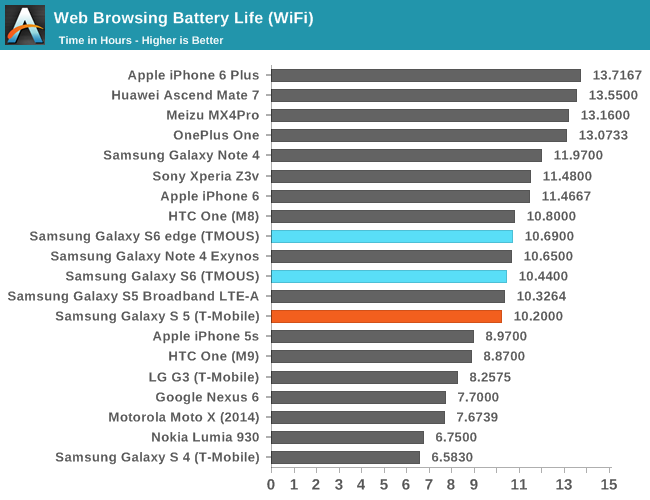
In web browsing, the Galaxy S6 manages to keep battery life while on WiFi at approximately the same level as the Galaxy S5. It’s likely that a combination of the newer Broadcom BCM4358, upgraded AMOLED display, and the Exynos 7420 helped to keep battery consumption relatively constant here, which represents a 10-15% overall power efficiency increase in this test. It’s likely that we’re mostly looking at differences in display efficiency when comparing the 1440p panel of the S6 to the 1080p panel of the S5. It’s definitely impressive that Samsung has pulled this off, but I do wonder what the result would be if Samsung stayed at 1080p.
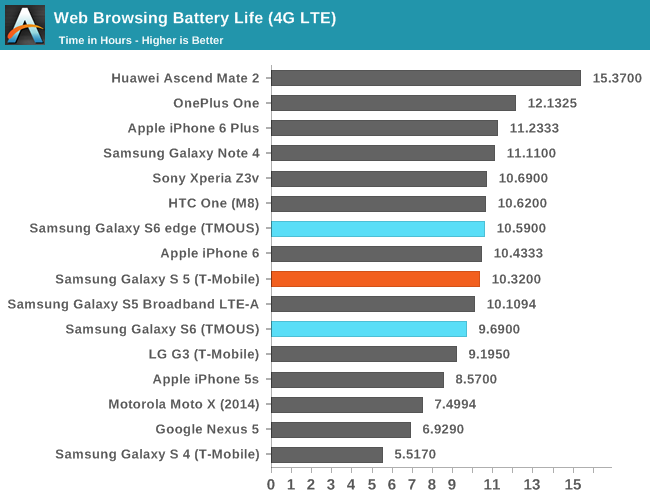
On LTE, we see a pattern that seems to generally mirror devices like the iPhone 6 with an external MDM9x25 Gobi modem. The Shannon 333 modem and Samsung’s other RF front-end components seem to be competitive with Qualcomm’s implementations, but given just how close WiFi and LTE battery life was with the Snapdragon 801 generation I suspect Qualcomm still holds an edge in average RF system power. The difference isn’t massive here, so it’s possible that this could simply be the difference between an external and integrated modem, but we’ll have to do a deeper investigation on power to be sure.
While web browsing is one of the crucial use cases, battery life experiences are often different when looking at multiple points in the curve. In order to get a better idea of battery life in less display-bound use cases, we’ll look at PCMark’s Work Battery Life test. Although not a fixed workload per unit time test like our web browsing test, it avoids strongly emphasizing display power at high APL scenarios and tends to be more CPU and GPU intensive, along with more mixed APL scenarios.

In this test, the Galaxy S6’s runtime in this battery life test is pretty close to the One M8 and One M9, but the major point of differentiation when compared to both is that the score throughout the test is significantly higher. It’s also important to note that the “battery” temperature during the test manages to stay much lower on the Galaxy S6 than on the One M9, which means that the SoC stayed in a more efficient mode of operation throughout the test as power consumption will rise with die temperature due to the way semiconductors work.
Now that we have a good idea of battery life in a display-bound and balanced workload, we can now look at SoC-bound workloads which include GFXBench and Basemark OS II. These tests are almost always limited by how much heat the case of the phone can carry away, and can often reveal weaknesses in how OEMs control throttling if a phone or tablet fails to complete either test. We’ll start by looking at GFXBench, which strongly stresses the GPU similar to an intense 3D game.

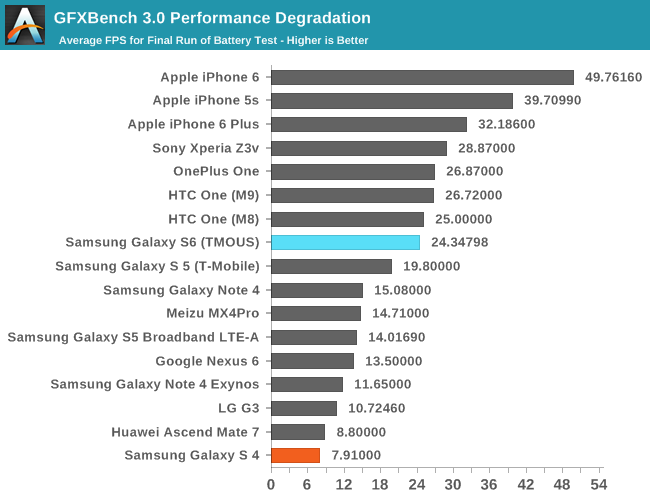
The Galaxy S6 ends up performing around the same level as the One M9 in terms of overall runtime, and the sustained frame rate ends up relatively similar as well. However, it’s critical to add context to this as the Galaxy S6 is running the test at 1440p, while the One M9 is rendering at 1080p. What this means is that the Mali T760 of the Galaxy S6 is sustaining a higher level of performance when compared to the Adreno 430 of the One M9 in this workload, even if that performance is “wasted” on rendering more pixels per frame. The one major issue here that is visible from the FPS vs time graph is that Samsung continues to struggle with graceful throttling as the GPU attempts to always target maximum performance, which causes a strong rise and fall in frame rate as the GPU goes through periods of high and low clock speeds determined by the thermal governor.
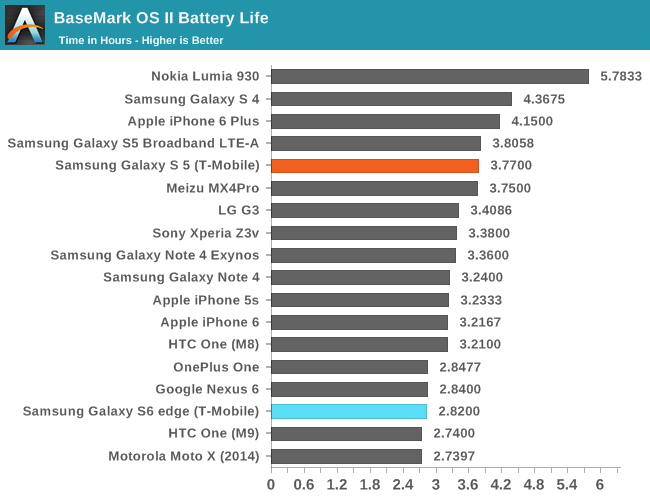
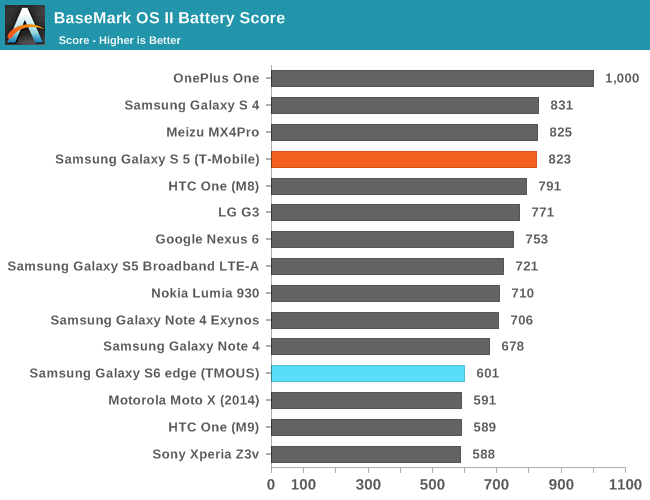
The final battery life test is Basemark OS II’s sustained CPU load test. Although it appears that the Galaxy S6 is comparable to the One M9 in this test, logging CPU frequencies over time reveals that the Exynos 7420 manages to keep the A57 cluster online throughout the course of the test at around 1.2 GHz, while the One M9 is forced to shut off the A57 cluster completely as the phone reaches skin temperature limits. Although both are kept at similar levels of normalized CPU load and run through the test for similar amounts of time, the Galaxy S6 manages to keep the CPU at a significantly higher performance level throughout the test. In general, it’s likely that the Exynos 7420 will be able to sustain overdrive frequencies for longer periods of time due to the massive process node advantages that come with Samsung’s 14LPE process.
Charge Time
Broadly speaking, much of the discourse around battery life as a whole has centered around time off of the charger. We can talk about how many hours of screen on time or total time a phone can spend on a battery, but charging time is often a critical to maintaining mobility. Removable batteries might be able to help with this problem, but if it’s easy to forget to charge a phone overnight, it’s just as easy to forget to charge a spare battery. Charge rate is often crucial for this reason, which is why we attempt to test it. In order to test this, we measure the time it takes to charge from a fully discharged battery to 100% either measured at the wall or indicated by a charging LED. The Galaxy S6 retains the same fast charge protocol as the Note 4, which seems to be QC 2.0 as the AC adapter negotiates fast charging with phones like the LG G Flex 2 and One M8.
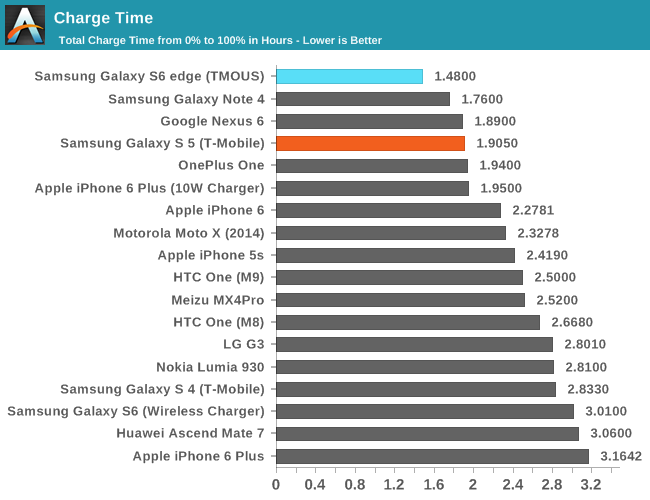
When using the included USB charger, the Galaxy S6 charges incredibly quickly. However, the wireless charger is noticeably slower than the wired charger, which is due to inefficiencies associated with wireless charging and the rather limited charge speed, which is appears to be limited to 1.5 amps at 5 volts. It’s a bit surprising to see that there is no option to disable fast charging the way there was with the Note 4 given that the battery is now sealed and rather difficult to replace, but I suspect most won’t notice a difference in lifetime unless the phone is used for more than 2-3 years.


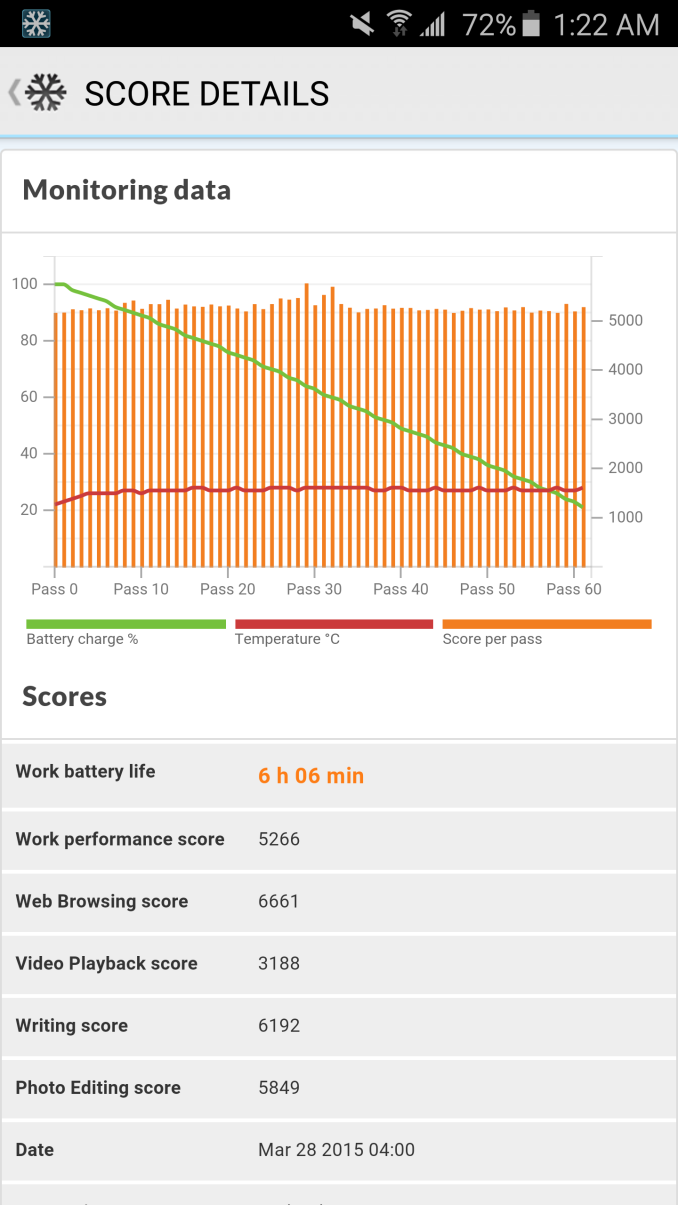
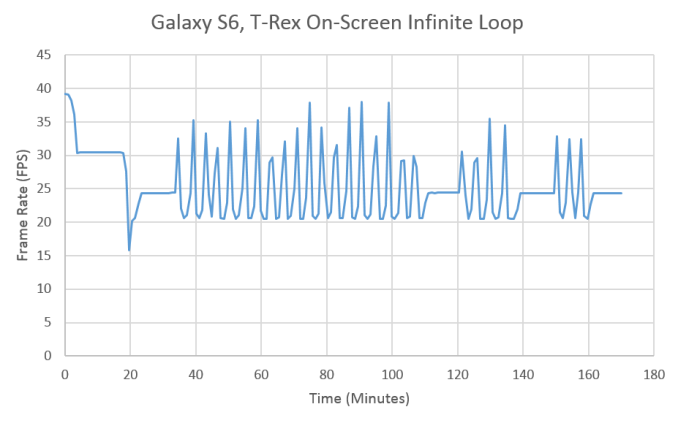
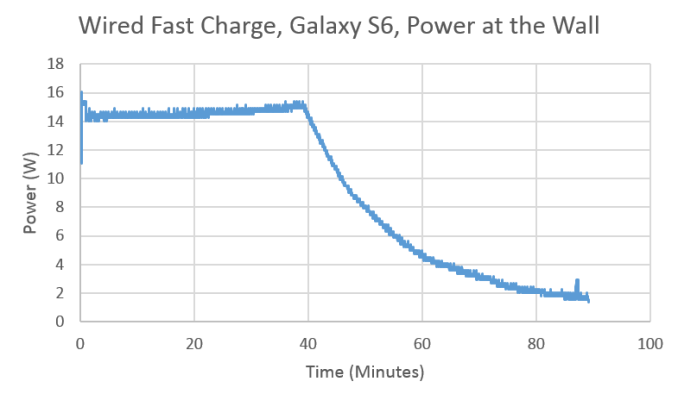
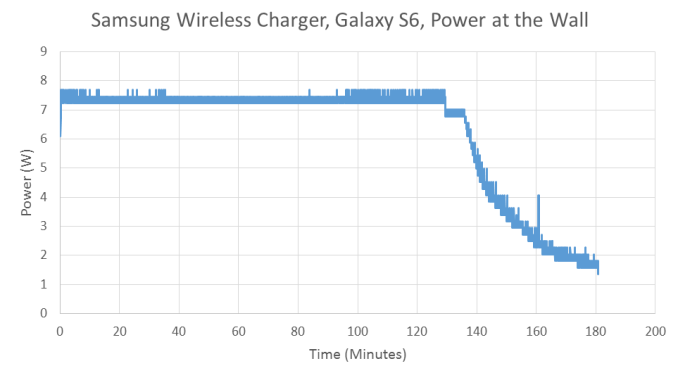








306 Comments
View All Comments
chizow - Saturday, April 18, 2015 - link
Yep exactly, I spend enough time tweaking my PC and at least it provides me proper tools to do so. After a few months with the S4 I just realized it wasn't worth it as the awful battery life and bloats OS made me want to just keep it in my pocket for fear of running out of juice when I actually needed it for phone functions.akdj - Sunday, April 26, 2015 - link
I'm ambidextrous. Use the 6+(personally) & Note 4 (family business of two decades). To be fair with your assessment the iPhone 5 sucked battery just as quick as the S4. At the time, comparable flagships for six months. 5S remedied it with iOS 7, but nothing like iOS 8 and the 6+'s battery size. It's physics and I'm with ya, not arguing. Just my two cents as my Note 4 with 5.0.1 is nearly identical to my 6+ with iOS 8.3 at the end of a 14-16 hour work and family day with similar usage shows similar reserves. Easily 50%. Usually high sixtiesThe memory leaks of yesterday and more granular control of apps and their background abilities on Amdroid (and the new core framework of 5.0), it's distribution of RAM (compression) and raw speed of the NAND makes the new generations of Android feel like iOS. Seriously. It's rare I run into less than 60fps manipulating the UI. And I use third party launcher Nova or Google. Samsung's stock browser is now not only capable but 'fast' and the displays have come a really REALLY LONG way since your S4. They're cool. Stop in and play with the hiDPI models like the S6 and Note 4. The latter of which hauls ass. And looking at these results, the S6 smokes it!
Across the board! And like us iOS dorks, Android's finally got a 128GB on board storage option. I'm as die hard SD card user as there is. I've got a Samsung Pro micro SD that just came out, & it screams! Awesome to pack with media and the like. But then again, I had two choices. White or black. 32 or 32GB. Even the fastest 64GB CF cards are over $200 to get to ½ the speed the S6's internals are reading and writing. And removable storage is prone to failure by user fault than non accessible OEM supplied 'system' optimized storage.
This latest batch of iOS and Android flagships have seen a significant increase in the internal read/write performance. Anyone that used or is using HDDs and have switched to an SSD knows the difference in perceived speed. It's the same on a phone when they've increased as much as they managed to in the past two years.
Especially this round. Note 4. The iPhone 6/6+. And now the king, look at those speeds on the S6. Those are insane and with the faster SoC, RAM (DDR4) and 'storage' I just talked about, along with the lollipop update and it's corresponding (massive) energy savings I've seen makes these 'phones' over the past ten months faster than computers we were using just five years ago. With higher resolution displays. Faster internet than even possible in most places then, wired! & we're getting those speeds on LTE! Wireless cell speed, increased horsepower, refined OS and leaps and bounds of improvements to AMOLED technology have made for a really tough decision which platform to go with. I'm still partial to iOS but only because of its integration and aggregation with OS X, my OS of choice. While I also use Win 8.1 and enjoy it ...neither system welcomes my browser of choice for nearly a decade. Chrome. Now 'Google Apps' it 'takes over' your computer. OS X or Windows, slow as molasses and it's a resource hog! Never thought I'd see the day IE and Safari would be my first choice(s).
Sorry to ramble. Just a view from someone not as responsible as yourself (I've no self control and can't decide between which, so both) and having continued ownership of both platforms since you switched, I'm floored by the improvements to Android, and their associated flagships. The displays are unbelievable when watching movies. Just awesome. Hard to explain how immersive a flick is on a 1440p 5.7" display with a killer set of cans ;)
Onsager - Friday, April 17, 2015 - link
Well written article, however given the few negatives, and very notable benchmarks, I am surprised it didn't receive a 'recommended' badge. The Exynos 7420 Soc itself deserves an award. In fact, numerous statements in the article certainly distinguish this phone as the current class of the field. 'What's a phone gotta do...'halcyonmax - Friday, April 17, 2015 - link
couldn't agree more.gnx - Friday, April 17, 2015 - link
+1Peichen - Saturday, April 18, 2015 - link
Is it necessary? The conclusion already states this is the best Android phone out right now.Onsager - Saturday, April 18, 2015 - link
By that rationale, no awards are ever necessary.akdj - Sunday, April 26, 2015 - link
That's kinda what I concluded. Awards? Who GAS? Hey quite honestly says this is hands down the Android 'king of the hill' (my quote) several times. Camera. Check. Display check. SoC - Yep, Whole page devoted to it eating the rest of the field for lunch. The only silicon that competes with it right now is the A8, Apple's second generation 64bit bad ass.Kinda cool Sammy did what they did with Exynos when the SD810 heat/throttling came to light. Good for them but I think I must've read a different article than you. This isn't a site for trophies and ribbons. And you don't have to read between lines
He actually says this is the BEST Android on the market and perhaps best overall phone. There's areas iOS best Android and vice versa. It's tough to say ones better than the other with 'numbers' ratings or some sort of star system. Bette to say it with words as the author (Josh? I'm sorry bud. Too lazy to look;)) has dome. It's right above this section.
It's called
"Final Words"
Babios - Friday, April 17, 2015 - link
I just had a hands on with both phones for more that an hour. Nice performance but too expensive for android phones. I am disappointed from a 1000€ phone (no sd, single sim, single speaker) and I can not feel it as a premium for that price range.You can buy a cheaper android phone that can cover your needs 99% with the 1/3 of the “Edge” price. S6 can score 70000 in Antutu but mine with 40000 is super fast in every game - application I have used.
Apple became cheaper that Samsung thats the news !!!!
magreen - Friday, April 17, 2015 - link
"As a reminder, power scales quadratically with voltage, so a drop from 1287.50mV to 1056.25mV as seen in the worst bin 1.9GHz A57 frequency should for example result in a massive 48% drop in dynamic power."It's a 33% drop in dynamic power, isnt' it?
(1287.5^2 - 1056.25^2) / 1287.5^2 = 0.327.
(The 48% number would be how much more power the higher voltage part uses than the lower voltage part, which is not the power drop.)